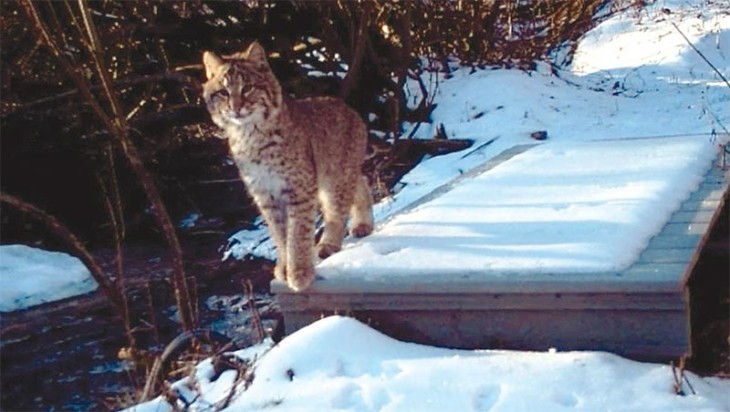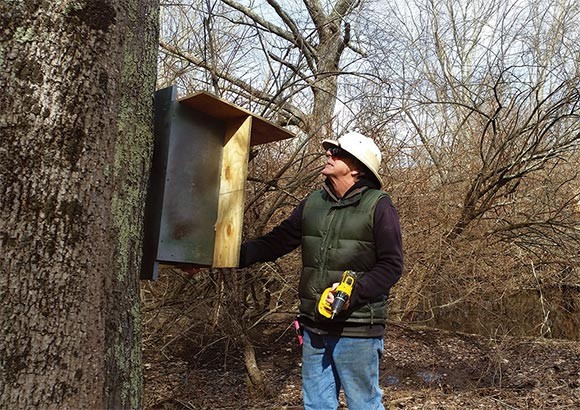The Fen is a private wildlife reserve in northeastern Connecticut. The 30-acre parcel was purchased in the spring of 2016 by Bet and Patrick Smith; here, Bet, who has a master’s degree from the Yale School of Forestry and Environmental Studies, describes the property, and the work she and her husband have undertaken to actively steward and conserve it.
Patrick and I have always enjoyed exploring the outdoors and observing wildlife. We are saddened whenever we see what I call “vinyl villages” eating up quality open space in our rural community. So we set aside some savings to buy and protect a nice piece of property if it became available. (We weren’t lucky enough to own any family land.)
We were studying old maps of Woodstock and noticed this undeveloped parcel very near where we live that had historic mineral springs on it; in the 1800s, people travelled to drink/bathe in the waters for health reasons. The land also borders a lovely brook that feeds the lake we live on. It looked like great wildlife habitat too. We often drove by the parcel and dreamed of being able to protect that piece from development. Then we saw a “For Sale” sign go up. We put in an offer the same day.
The property could have accommodated multiple houses, and was attractive because of the waterfront, although portions were too wet to develop. Because we assured the seller that we were going to conserve the land, he gave us a good price. Our will contains a provision to donate the property to the contiguous Roseland Park, so it will be maintained as open space in perpetuity.
Before we bought it, the land was the epitome of inactive stewardship – it had not been touched for 40 years, except for periodic mowing of a small meadow. At first, we really could only see a few acres of the property – the rest was impassable, due to fallen trees and huge overgrown thickets of Japanese barberry, multiflora rose, Asian bittersweet, burning bush (winged euonymus), autumn olive, and on and on.
Aerial maps showed that in 1934, most of the land had been clear-cut and drained for agriculture. Huge stumps indicated pines had been logged more recently. Today, the land hosts a luscious variety of habitats – a brook that feeds Roseland lake, a three-acre meadow, wetlands (with numerous vernal pools supporting wood frogs and salamander reproduction), cathedral pines, lots of red maple, some oak, and lots of invasive plants and ticks.
Once we owned the property, we needed to refer to it as something. In the first two days we explored it, everything we encountered was wet, so The Fen seemed like the perfect name.
Our first step was to address access – clearing trails and building bridges. It often took us an entire day to hack our way through just 100 feet of tangled brush. Patrick set up a game camera so we could learn about what was happening when we were away. We were amazed at how much animal and bird activity there was!
Then we looked for a forester to develop a forest management plan. Through the New England Forestry Foundation (NEFF) we connected with Eric Hansen, who works for Ferrucci & Walicki and in 2018 won the Young Forester Leadership Award from the New England Society of American Foresters. We quickly saw that he would be a great fit with our goals, in terms of his knowledge of habitats, wildlife conservation, controlling invasives, and working with the Natural Resource Conservation Service (NRCS). He is also a very patient, fun guy (and you gotta love someone who names their firstborn son Burl).
After establishing trails, we focused on invasive plant control, primarily through mechanical means. We wanted to get rid of the seed source and open up the land for native species. In particular, I would love to wipe out the barberry and winged euonymus. Barberry is prime habitat for deer ticks, and an estimated 42 percent of ticks in our region are infected with at least one tick-borne pathogen. The winged euonymus is incredibly prolific, and nothing else will grow beneath it. Birds don’t even use it for nesting. For the particularly infested area around the meadow, I hired Billie Carver, who has specialized equipment that was able to accomplish more in eight hours than I could have done in eight months. He was also skilled at saving any existing native plants.
A friend told me about cost-sharing grants that were available from the NRCS under the Environmental Quality Incentives Program (EQIP). I read up on it, and went over to meet with the folks at our regional office. The NRCS grant money we received helped us pay for the forest management plan, and we subsequently entered into a five-year contract with them to implement the plan. The grant includes funding for improving the access road, protecting the culvert with swamp mats, invasive plant control, thinning for forest health, installing nestboxes for bluebirds and wood ducks, and patch cuts for woodcock and other wildlife. Although some folks may be reluctant to get involved with government programs because of the paperwork and oversight, I have found it to be a huge boon. For example, NRCS engineers came out and designed our access road, their foresters did walkthroughs and shared valuable information and tips, and the grant money has provided significant financial assistance to help us achieve our goals for the property.
We’ve invited in groups for fun, educational walks, in conjunction with local non-profits like NEFF. It’s hard to find marshy areas that are as accessible as Patrick has made ours with the trails and bridges, so it’s a unique opportunity for people to get inside a living, breathing New England wetland. We created a Facebook page and post weekly films from our wildlife cams: a barred owl dragging an earthworm out of the mud, a fisher with three babies, our resident bobcats marking trails, beavers weaving sticks into their dams, and more. A hunter bow-hunts on the property, and we get a portion of any venison he harvests there. Since most of the wood is swamp maple and weevil-damaged pine, it’s not economically viable to do a timber sale, but we do plan to harvest some firewood.
Creating what is now The Fen has been a fun and challenging project. The land gives us opportunities for exercise and quality time together as a couple, and we have both gained a sense of pride and feeling of accomplishment.







Discussion *